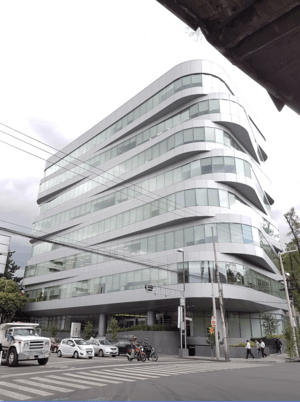Comisión Nacional de Hidrocarburos (Mexico)
 | |
 | |
| Agency overview | |
|---|---|
| Headquarters | Av. Patriotismo 580, Noanalco, Benito Juárez, Mexico City, 03700 |
| Website |
gob |
The National Hydrocarbons Commission (CNH) is an agency of the Federal Executive, with legal personality, budgetary autonomy and self-sufficiency technique whose operates in strict compliance with maximum transparency and accountability principles. These principles are established in the Constitution, the Coordinated Energy Regulatory Bodies Law, as well as its internal regulations, setting a new national and international benchmark.
The CNH was founded as a Federal Executive Agency, with full legal capacities, technical autonomy and budgetary self-sufficiency. CNH´s highest authority is the Board of Commissioners, composed of seven members. For each of their appointments, the President nominates three candidates and the Senate designates one of them. Currently, this board is made up of Juan Carlos Zepeda, President Commissioner and Commissioners Alma America Porres Moon, Nestor Martinez Romero, Hector Felix Alberto Acosta, Sergio Pimentel Vargas, Hector Moreira Rodriguez and Franco Gaspar
Objectives
- Develop information and knowledge of Mexico´s basins. CNH manages the National Data Repository, which contains information from seismic, gravimetric and magnetometric studies, obtained through exploration and production activities. In addition, it will keep and preserve well cores, drill cuttings and oil samples, necessary for the country´s historical and prospective hydrocarbon knowledge.
- Conduct public tenders and sign contracts for exploration and production of hydrocarbon knowledge.
- Manage assignments and E&P Contracts.
- Regulate and supervise geophysical and geological prospection activities as well as hydrocarbon exploration and production, including its collection and integration to transportation and storage systems.
History
On April 8, 2008 the Executive presented a series of reforms to Article 27 of the Constitution of Mexico and to secondary laws regulation the oil sector in Mexico.
Among the proposals to Congress the creation of a National Hydrocarbons Commission which shall endeavor to found "that the exploration and extraction are carried maximizing oil rents in the extraction of crude oil and natural gas."[1] The amendment was approved in October 2008, including as regards the Commission, which is formally established with the publication in the Official Journal of the Federation of Law of the National Hydrocarbons Commission on November 28, 2008
CNH was formally installed on May 20, 2009 when Felipe Calderon, President of Mexico, appointed by the five members of the commissioners who formed its governing. This first Board of Commissioners were Juan Carlos Zepeda Molina, Edgar Rene Rangel Germán, Javier Humberto Estrada Estrada, Guillermo Cruz Dominguez Vargas and Eduardo Alfredo Guzman. The first was appointed as commissioner in May presidente.
The Reform Proposals of the government of Enrique Peña Nieto on energy carried out under the so-called Pact for Mexico, whose goals include reforming the functions of the National Hydrocarbons Commission to give greater strength and give authority to sign contracts and tenders in energy. Also given powers of supervision and promotion of activities petroleras. In early April 2014 the drafting of the amendments to articles 25, 27 and 28 of the Constitution and the Law on the National Commission of Hydrocarbons you were finished and It is waiting to be approved by both Cámaras.
On April 29, 2014 Juan Carlos Zepeda Molina was reelected as president of the Commission for a period of 5 years.
Organization
The current composition of Board of Commissioners is:
- Juan Carlos Zepeda Molina, President Commissioner
- Alma América Porres Luna, Commissioner
- Néstor Martínez Romero, Commissioner
- Héctor Alberto Acosta Félix, Commissioner
- Sergio Pimentel Vargas, Commissioner
- Héctor Moreira Rodríguez, Commissioner
- Gaspar Franco Hernández, Commissioner
Regulatory highlights
- Technical Provisions to Avoid or Reduce Flaring and Venting of Gas in the Exploration and Exploitation of Hydrocarbons[2]
- Technical Guidelines for Designing Hydrocarbon Exploration and Exploitation Projects and their Evaluation[3]
- Guidelines Regulating the Ruling Process for the Approval of Evaluation and Quantification Reports of Hydrocarbon Reserves Developed by Petróleos Mexicanos and the Approval of the Final Reports of the Certifications Completed by Independent Third Parties[4]
- First Technical Paper of Oil and Gas Recovery Factors[5]
- First Review of the Tertiary Gulf Oil Project[6]
References
- ↑ "Ley de la Comisión Nacional de Hidrocarburos" (PDF). Cnh.gob.mx. Retrieved 2012-10-27.
- ↑ "Comisión Nacional de Hidrocarburos - Disposiciones técnicas para evitar o reducir la quema y el venteo de gas". Cnh.gob.mx. 2010-10-27. Retrieved 2012-10-27.
- ↑ Archived July 22, 2011, at the Wayback Machine.
- ↑ "Secretaria de Energia Comision Nacional de Hidrocarburos: Resolucion" (PDF). Cnh.gob.mx. Retrieved 2012-10-27.
- ↑ http://www.cnh.gob.mx/_docs/DOCUMENTOTECNICO1FINAL.pdf
- ↑ "Proyecto Aceite Terciario del Golfo" (PDF). Cnh.gob.mx. Retrieved 2012-10-27.